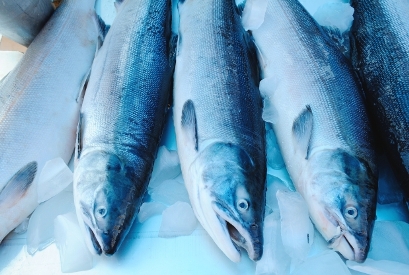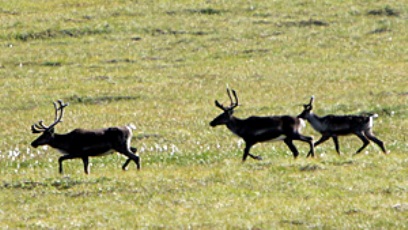
August 19, 2012
Salmon caught off the coast of British Columbia will be tested for traces of radiation from the nuclear disaster in Japan, the Canadian Food Inspection Agency has announced.
カナダ食品調査機関は、BC州沖で取れるサーモンに対して、日本の原発災害による放射能の痕跡を検査することを発表しました。

The Fukushima Daiichi nuclear plant in northeastern Japan failed following the earthquake and tsunami that hit the country in March. The power company which owns the reactor said highly radioactive water (about 100,000 times the normal level) from the reactor had leaked into a trench, contaminating nearby water and the air.
日本の東北にある福島第一原子力発電所は、3月に地震と津波が襲った後、機能を失いました。その発電所を所有している電力会社は、原子炉から通常の10万倍の(8月19日のNHKニュースによると、最も多いとされる事故直後の3月15日には、今回の評価-いまだに放出されている2億ベクレル-の1000万倍となる1時間当たり2000兆ベクレルが放出されている、とのこと)高度の放射能を含む水がトレンチに漏れ、付近の海と大気を汚染ている、と述べました。
"The monitoring of fish off the coast of B.C. is part of a series of measures intended to monitor the impact, if any, of the nuclear crisis in Japan," Alice D'Anjou, a spokeswoman for the CFIA, told Postmedia News in an email. The agency does not expect to find harmful levels of radiation in the fish, D'Anjou said.
「BC州沿岸沖の魚を検査するのは、日本の放射能危機からの影響を-もしあるとすれば-監視する目的でされている一連の測定の1つです。」と、カナダ食品調査機関のスポークスマンであるAlice D’AnjouはPostmediaニュースにEメールで言いました。「魚に害があるレベルの放射能が見つかるとは思っていません。」
"If it's sockeye (salmon), then it's a wise precaution," said fisheries oceanographer Tony Pitcher from the University of British Columbia. Sockeye salmon migrate quite far north and west in the Pacific Ocean into waters that are also crossed by currents coming from Japan, Pitcher said, so there is a chance the salmon will come into contact with organisms carrying some radiation.
「もしそれがSockeyeサーモンだとすると、賢明な予防策となります。」と漁業海洋学者のBC大学のTony Picherは言います。Sockeyeサーモンは、太平洋のはるか北と西、日本からの海流が交差する太平洋を移動しているので、放射能を運んできている有機物を吸収している可能性があります。
Whether the salmon are affected by the radiation depends on what the salmon eat, Pitcher said, and also on the half-life of the particular radioactive isotope that entered the food chain from the reactor.
サーモンが放射能による影響を受けているかどうかは、サーモンが食べているもの、そして原子炉から、海の食物連鎖に入り込んだ放射性元素体の半減期によるのだと言います。
Pitcher said it is not likely the fish will reveal contamination, but it is important to test them and rule out the possibility. Other salmon species such as Koho and pink salmon do not migrate as far as sockeye and spend less time at sea, he said, so they are much less likely to be affected by the reactor failure.
Pitcher氏は、魚から汚染が出るということはおそらくないであろうけれども、その可能性を除外するためには重要だ、と話しました。Kohoやピンクサーモンのようなほかの種類は、Sockeyeほど移動せず、海にいる時間が短いので、この原発事故による影響が出ることはほぼないであろう、とも話しました。
The CFIA has already tested air quality, B.C. milk and Japanese imports and found no harmful levels of radiation. The sampling is already underway and will continue until September, D'Anjou said.
カナダ食品調査機関はBC州で既にミルク(結果はこちら)と日本からの輸入品を検査し(結果はこちら)、害のある値の放射能は検出されていません。このサンプル調査は既に進行中で、9月まで続けられます。とD‘Anjouは述べました。(食品とえさの輸入が解除された後のデータが更新されていないのが、とても気になります・・・)
Meanwhile, Yukon's Department of Health also plans to test the Porcupine caribou herd for radiation from the reactor meltdown.
一方、ユーコンの衛生局は、原子炉のメルトダウンを受けて、カリブーの群れの放射能検査を計画しています。
"There is no reason to believe any significant contamination from radiation has occurred," said Brendan Hanley, chief medical officer of health for the territory, in a statement released Thursday. "We just want to reaffirm that the caribou are safe to eat."
「放射能による重大な汚染が発生していると言う理由はありません。」と、ユーコン準州の衛生局医療チーフのBrandan Hanleyは、木曜日の発表で語りました。「ただ、カリブーが食しても安全だということを、断言したいのです。」

Photo from CBC
According to the Porcupine Caribou Management Board, Porcupine caribou are hunted mostly by Gwich'in, Northern Tutchone, Han, Inuvialuit and Inupiat peoples in Yukon, the Northwest Territories and Alaska. The meat is a staple food and the hide is used to make clothing such as mukluks and parkas.
カリブー管理委員によると、カリブーはユーコン、ノースウェスト準州とアラスカの先住民族により狩猟されるとの事です。その肉は、必需食で、その皮は、彼らの履物、衣服に使われます。
The herd has been monitored on an ongoing basis for 15 years for other contaminants.
この群れの調査は、他の汚染を調べるために、15年間進行中です。
Copyright (c) Postmedia News
そして、こちらは、昨日(8月19日)のCBCのニュース。
Here is CBC News report on August 19, 2012.
(スティーブンストンの市場で、ぜんぜん気にしてないお客さんたちのコメント「遠すぎるすぎるよ。バンクーバー島がブロックしてくれるしね。」売り手はビジネスの妨げを恐れコメントは控えたい、と。動画があります。)
Here is CBC News report on August 19, 2012.
West Coast fish to be tested for Fukushima radiation
西海岸で取れる魚は福島からの放射能検査が行われる
~重複のため、冒頭略~
Fisheries activist Alexandra Morton with the Raincoast Research Society says she supports the testing, but calls the announcement a political move. Morton says millions of sockeye have started returning to the Fraser River and the fishing season is already well underway.
漁業活動家のAlexandra Mortonさんは、レインコーストリサーチと共に、この調査を指示するといいます。ただ、この発表を、政治的手段、と呼びました。モートンさんはフレーザー側に何百万匹のSockeyeサーモンが戻り始めていて、漁業の季節が既に進行中だと話しました。
Salmon are a particular concern to Morton and others because their wide-ranging migration patterns can take them right across the Pacific Ocean to the coast of Japan.
サーモンは、広域にわたる移動習性から、太平洋を渡り、日本の海岸沖まで至る可能性があると、Mortonさんや他の人にも特に懸念されています。
"If they were actually concerned about the health of people and the fish, they would have started this actually at the beginning of the commercial openings. But to release this two days before the disease hearings at the Cohen inquiry, to me it's a political statement, it's a political effort to appear responsible," she said.
「人々と魚の健康をきちんと考えるのならば、解禁された始めの時期に始めるべきでした。 Cohen調査(オイルを西海岸に流したときの政府の査定、対応が、海洋生物の汚染、フレーザー川のサーモンの減少の原因となっているというような事象)のヒアリングの2日前に発表すると言うのは、政治的声明であり、責任感の強さをアピールするために感じられます。」
The Cohen Commission hearings into the collapse of the 2009 Fraser River sockeye salmon run resumed in Vancouver earlier this week.
2009年、フレーザー川のSockeyeサーモン上り崩壊についてのCohen委員会のヒアリングは、バンクーバーで、今週はじめに再開されました。
Morton also wants the CFIA to test farmed salmon, because she says trace amounts of radiation were detected in seaweed on the B.C. coast.
Mortonさんは、食品調査機関に養殖のサーモンについても検査してもらいたいと思っています。BC州沿岸の海藻から微量の放射能が検出されたからです。
Radiation levels soared in Japan
日本で放射能レベル激増
Following the failure of the Fukushima Daiichi nuclear plant in northeastern Japan, concentration of radioactive iodine-131 in seawater in the area soared to 1,250 times the normal figure, the Japanese Nuclear and Industrial Safety Agency said in March.
福島第一原発事故の後、海水のヨウ素131の濃度が通常の数値の1250倍(繰り返しますが、8月19日のNHKニュースによると、最も多いとされる事故直後の3月15日には、今回の評価-いまだに放出されている2億ベクレル-の1000万倍となる1時間当たり2000兆ベクレルが放出されている、とのこと)に跳ね上がった、と日本の原子力安全・保安院は3月に述べました。
Radiation began seeping from the plant when a magnitude 9 earthquake and a tsunami on March 11 knocked out its cooling systems. The contamination has made its way into milk and vegetables, including broccoli, cauliflower and turnips tested in Japan.
マグニチュード9の地震と津波が3月11日に発生し、原発の冷却機能を破壊したとき、原発からは放射能が漏れ出しました。その汚染は、日本で検査された牛乳、ブロッコリー、カリフラワー、カブなどの野菜などに広がっていました。
But radioactive iodine-131 has a half-life of eight days, which means in several weeks its threat reduces to a minuscule level, according to nuclear experts.
しかし、ヨウ素131の半減期は8日です。放射能専門家によると、これは、数週間後に、その脅威は非常に小さいレベルになることを意味している、とのことです。
Canadian tests found no concerns
検査した食品は全く心配なし
CFIA says it tested 165 food and feed products imported from Japan after the disaster and found all were below Health Canada's levels for concern.
食品調査機関は、災害後、日本から輸入された165の食品と動物のえさを検査し、全てがカナダ衛生局が懸念するレベルを全て下回っていました。
The agency also tested 34 samples of domestically produced milk from British Columbia and all were found safe for consumption.
国内で生産されたBCの牛乳の34サンプルも検査しましたが、全て体内摂取に安全だと分かりました。
Negligible levels of radioactivity in the atmosphere were also detected along the West Coast by monitoring stations following the disaster.
災害後は、西海岸の観測所で環境内にわずかな放射性物質が検出されました。
"The radiation levels found on the West Coast are less than the natural levels of radiation that would be detected when it rains or snows," said a statement released by the CFIA.
「西海岸で見つかった放射能レベルは、雨や雪のときに検出される自然界の放射能レベルよりも低いものです。」と、食品調査機関は声明文の中で発表しました。
一方・・・・
グローバルに見た放射能汚染の広がりは、(3/12~26)
8月4日のバンクーバー地元紙、Straight.comでは、

August 4, 2012
For 22 days, a Health Canada monitoring station in Sidney detected iodine-131 levels in the air that were up to 300 times above the normal background levels. Radioactive iodine levels shot up as high as nearly 1,000 times background levels in the air at Resolute Bay, Nunavut.
(3月18日から)22日間、カナダ衛生局がシドニー観測所で大気中に通常の300倍のヨウ素131を検出しました。Nunavut準州のResoluteベイでは通常の1000倍に近い値まで跳ね上がりました。
Meanwhile, government officials claimed there was nothing to worry about. “The quantities of radioactive materials reaching Canada as a result of the Japanese nuclear incident are very small and do not pose any health risk to Canadians,” Health Canada says on its website. “The very slight increases in radiation across the country have been smaller than the normal day-to-day fluctuations from background radiation.”
一方政府筋は、「日本の原発事故によって放射能物質がカナダに到達する量はとても少なく、国民の健康障害を引き起こすものではない。」とウェブサイトで語りました。「カナダ全国を通しての放射能のわずかな増加は、環境からの日々の通常の変動よりも小さいものです。」
In fact, Health Canada’s own data shows this isn’t true. The iodine-131 level in the air in Sidney peaked at 3.6 millibecquerels per cubic metre on March 20. That’s more than 300 times higher than the background level, which is 0.01 or fewer millibecquerels per cubic metre.
実際にカナダ衛生局自信がが示しているデータが、真実でないことを語っています。シドニー(バンクーバー島)の大気中のヨウ素131のレベルは、3月20日に3.6mBq/ m3 でした。それは自然環境レベル、0.01mBq/ m3以下より300倍高いものです。
“There have been massive radiation spikes in Canada because of Fukushima,” said Gordon Edwards, president of the Canadian Coalition for Nuclear Responsibility.
「福島によるカナダの大量放射能激増があったのです。」とカナダ核責任連合の代表、Gordon Edwards氏は言いました。
“The authorities don’t want people to have an understanding of this. The government of Canada tends to pooh-pooh the dangers of nuclear power because it is a promoter of nuclear energy and uranium sales.”
「政府は人々にこのことを知らせたくないのです。カナダ政府は原子力の危険性についてははぐらかす傾向にあります。原子力発電推進者であり、ウランビジネスのためです。」
No comments:
Post a Comment